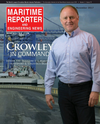
Page 82: of Maritime Reporter Magazine (November 2017)
The Workboat Edition
Read this page in Pdf, Flash or Html5 edition of November 2017 Maritime Reporter Magazine
Coast. At the American Association of Upon completion in 2016, the “neo- Bridge in Long Beach is also underway. approval to do so, in 2015).
Port Authorities (AAPA) annual conven- Panamax” vessels began transiting When completed in 2018, the larger ves- Existing infrastructure is stretched. tion, held in early October, Mr. Mark Sis- through Panama – bringing Asian cargo sels will be able to enter terminals near Commenting on the impact of liner al- son, Senior Port Planner at engineering to the East Coast. CMA CGM, owners of downtown. liances, Mr. Cordero said: “Going for- behemoth AECOM, told his audience: the Franklin and Roosevelt, is now set to ward, we may have fewer port calls, “The pace of the ship size increase has begin a regular routing of vessels up to but each port call may involve more
Beyond Deeper Draft really caught a lot of folks by surprise, 14,000 TEU from Asia to the East Coast. The larger vessels pose challenges for signi? cantly more container movements and ports are scrambling to catch up to “We’re thrilled to have CMA CGM T. ports, and the landside infrastructures within the port terminals.” These com- this day.” Roosevelt call at our port and serve as that link them to hinterlands. With eco- ments jibe with results of a recent survey
The Panama Canal also got the mes- the celebratory vessel for the raising of nomic growth, TEU throughput will by Navis (part of Cargotec Corporation), sage, embarking in 2006 on a $5.5 bil- the Bayonne Bridge,” Molly Campbell, continue to grow. At the AAPA confab, a leading provider of Terminal Operat- lion project that would allow vessels of Port Director at the Port of New York Mr. Mario Cordero, the former Chair- ing System (TOS) software, where 76% up to 14,000 TEU to transit (contrasted and New Jersey, explained in a prepared man at the Federal Maritime Com- of respondents listed “optimizing opera- with the previous size constraint of statement. “We invested billions of dol- mission (FMC), who recently became tions to improve productivity” as their roughly 5,500 TEU). Though only 500 lars to raise the Bayonne Bridge, deepen Executive Director at the Port of Long biggest challenge. boxes were discharged by the Regina harbor channels, install rail facilities at Beach, provided some guideposts on MLPro also spoke with FMC Com-
Maersk at New York, port planners there all of our terminals and improve our port anticipated growth. Referring to the San missioner William Doyle regarding the began looking in earnest at deep dredg- road network, with the goal of attracting Pedro Bay port complex (Long Beach challenges of mega-ships, and the re- ing (in a project that began in 2004), the world’s biggest ships and cargo to and Los Angeles), Mr. Cordero pegged verberations down the supply chain. He and at raising the air-draft of the 1930’s our port and the jobs and economic ac- 2015 throughput at 15.4 million boxes, said, “Ocean carriers are building larger vintage Bayonne Bridge to 215 feet, in tivity they provide,” she added. and then offered forecasts of 28.3 mil- ships and those larger ships are now a $2 billion project that commenced in But, harbor development is not re- lion and 41 million boxes for 2030 and coming to East and Gulf coast ports as 2013 and is now complete. Down the stricted to the East Coast. In Southern 2040 respectively. He continued, “Mov- a result of the newly expanded Panama
East Coast and into the U.S. Gulf, ports California, the 10 year channel deep- ing forward, we need to focus on ef? - Canal. If you are a port and you want have already ? nished, or are now in the ening at the Port of Los Angeles (com- ciencies in the supply chain,” explaining more business, the ocean carriers need midst of channel deepening projects – pleted in 2013) saw creation of a pas- that Los Angeles and Long Beach are the proper infrastructure to be in place. typically to 50 feet depths that will allow sage of 53 feet in depth. A $1.5 billion working cooperatively on a supply chain And that means the harbor and chan- transits of ships as big as 18,000 TEU. bridge replacement for the Desmond optimization project (after gaining FMC nels must be dredged, purchasing of new
The CMA CGM T.Roosevelt heads for Port Newark and to the Kill Van Kull before transiting under the newly raised Bayonne Bridge.
In the foreground (L to R): FMC Commissioner William Doyle, PANYNJ Port Director Molly
Campbell, FMC Commissioner Dan Maffei and Panama Canal Administrator Jorge Quijano.
82 Maritime Reporter & Engineering News • NOVEMBER 2017
MR #11 (82-89).indd 82 MR #11 (82-89).indd 82 11/6/2017 5:38:34 PM11/6/2017 5:38:34 PM

 81
81

 83
83
